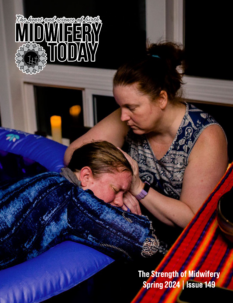
Photo by Brett Zeck
Global Midwifery—Traditional and Official—and Humanization of Birth
Editor’s note: This article first appeared in Midwifery Today, Issue 83, Autumn 2007. This speech was given at the May 2007 Midwifery Today conference in Costa Rica. This article is available in Spanish here: La Partería Global—Tradicional y Oficial—y la Humanización del Nacimiento
Subscribe to Midwifery Today Magazine
Prior to 200 years ago all birth care around the world was humanized as it was attended by midwives, kept the woman in the center and, in general, respected nature and culture.
After World War II came the technological age. If we can put a man on the moon, surely we can also have perfect birth. So without any scientific data to justify such a move, childbirth was moved to hospitals with doctors and machines and drugs. Midwives were marginalized, with no role for women or family, and birth became medicalized.
In the 1980s and 1990s women began to react against this and began a move to humanized birth. Humanized birth means that the woman giving birth is in the center and in control so that she, and not the doctors or anyone else, makes all the decisions about what will happen. Humanized birth means understanding that the focus of maternity services is community-based primary care, not hospital-based tertiary care. Humanized birth is with midwives—traditional and official, nurses and doctors working together in harmony as equals. Humanized birth means maternity services that are based on good scientific evidence including evidence-based use of technology and drugs.
The past fifteen years has seen an intense and global struggle between medicalized birth and humanized birth. Today three kinds of maternity care exist: the highly medicalized, “high tech,” doctor-centered, midwife-marginalized care found, for example, in the US, Russia, Eastern European countries and urban areas of developing countries; the humanized approach with strong, more autonomous midwives and much lower intervention rates found, for example, in the Netherlands, New Zealand and the Scandinavian countries; and a mixture of both approaches found, for example, in Britain, Canada, Germany, Japan and Australia.
Throughout history, women (midwives) have been in communities for other women to turn to for support with women’s concerns—not just reproductive health care, but also issues such as spousal abuse. The word midwife is early English for “with woman.” The French word for midwife, sage femme (wise woman), goes back thousands of years, as do the words in Danish, jordmor (earth mother), and in Icelandic, ljosmodir (mother of light). Hippocrates formalized a midwifery training program in Greece in the fifth century BC. Phaenarete, the mother of Socrates, was a midwife. In the Bible, the Book of Exodus recognized the strength and independence of midwives who defied the Pharaoh’s command that they kill all sons born to Hebrew women. The first law to regulate midwifery in Europe was passed in Germany in 1452 and required a midwife to be in attendance at every birth.
What about the practice of midwifery attracts so much hostility and criticism? Midwives are at the center of the “women’s world.” Throughout history there has always been a women’s world running parallel to the men’s world, existing under the men’s radar. Midwives are strong, independent women in the community, women who are difficult for men to control and whom some men come to fear.
Every attempt at ending the practice of midwifery has failed. It seems that there will always be women who want to be midwives and women who want midwives to attend them when they give birth.
In rural areas of Latin America, traditional midwives have continued to attend births, while in urban areas birth has become medicalized, in some areas such as Brazil to an extreme degree. Recently signs can be seen of the beginning of a humanization of birth in Latin America. In 2000 in Fortaleza, Brazil, an international conference attended by over 2000 people endorsed the humanization of birth. The government in Brazil is now sponsoring free-standing out-of-hospital birth centers and the training of midwives to staff them.
As the medicalization of birth spread throughout urban Latin America, doctors began to define traditional midwives as “primitive” with nothing to contribute to maternity care. The many years of suppressing traditional midwives left the public confused about the role of traditional midwives. In rural areas, women often turned to traditional midwives, even when doctors and other health professionals were available.
The World Health Organization (WHO), after evaluating maternity care, recommended that:
[i]nformal perinatal care systems (including traditional midwives), where they exist, must coexist with the official birth care system and collaboration between them must be maintained for the benefit of the mother. Such relations, when established in parallel with no concept of superiority of one system over the other, can be highly effective. In industrialized countries some women will always want to use alternative practitioners such as traditional midwives. These alternative providers are important in developing countries.
In regard to recommendations regarding Latin America the WHO states:
In many countries in Latin America some areas are still not served by official health care and there are sizable groups of people who choose to use alternative services, even when the official ones are available. As a result, large numbers of births in Latin America are still attended by traditional midwives. With a few exceptions, they are not recognized as professionals by the government. Their exclusion from the official health system eliminates the possibility for the referral of women with problems, thus reducing the accessibility of official care and the options available to the woman who develops complications of birth. In addition, traditional midwives neither benefit from the knowledge in obstetrics and formal midwifery nor contribute their own knowledge of the local culture of birth and traditional birth practices to other health professionals.
The WHO continues:
WHO studies have shown that attempts in many countries to eliminate traditional health practitioners such as traditional midwives through legislation and other means have only driven these practitioners underground. Legislation prohibiting traditional midwives is rarely enforceable. In the few countries where such prohibitions have been enacted, traditional midwives continue to work, accepted by the community and often preferred to the modern health system; the real effect of such legislation has been to force traditional midwives to work in secret or to prevent them from being trained. Yet they are tolerated and sometimes found indispensable by health centers. Legislation should facilitate training of traditional midwives and authorize them to perform tasks within their competence, rather than set down unenforceable and unrealistic prohibitions.
A WHO meeting report stated:
It is now almost universally acknowledged that unless the traditional health practitioners (including traditional midwives) are properly recognized and articulated with the national health system, countries will never be able to achieve adequate health coverage for all their populations. Almost everywhere, attempts to upgrade the skills and knowledge of traditional midwives and to mobilize them to play an effective role in the health system have met with resistance from organized groups of health professionals with vested interests in maintaining the status quo. The development of a policy favorable to traditional midwifery depends on the enlightened understanding of the nature of such care and the role and resources of its practitioners, many of whom possess a fund of wisdom, knowledge and experience that can only serve to improve the quality of care that countries provide for their populations. Traditional midwives constitute a major and valuable reserve of human resources that must be better utilized within every country’s health service, if the health status of the population is to be improved. Governments should formally recognize and legitimize the practice of traditional midwives. In countries where existing legislation is not supportive of traditional midwives, supportive policies should be adopted as a temporary measure until the more time-consuming process of legal reform can be carried out. Where existing legislation presents a barrier to the promotion of traditional midwifery, it should be repealed, or amended, and ultimately replaced by supportive legislation. The experience of countries shows that legislation prohibiting the practice of traditional midwives does not succeed.
The WHO Report continues:
The whole group agreed on the benefits of integrating traditional midwives into the perinatal care system. Everyone involved would profit: traditional midwives, other health care workers and, most importantly, the women giving birth. Both formally trained official midwives and traditional midwives emphasize the social perspective, which stresses normality and social and cultural sensitivity. Recognition of this view creates a better balance in the maternity care system. The informal perinatal care system (including traditional midwives) must coexist with the official birth care system, and collaboration between them must be maintained for the benefit of the mother. Such relations, when neither is held to be superior, can be highly effective.(1)
Midwives (both traditional and formally trained) are primary women’s health care workers. When a problem arises in a woman under their care, midwives can refer the woman to an obstetrician. This is analogous to a family physician referring a patient to a specialist, such as a cardiologist. Obstetricians do not give orders to midwives any more than cardiologists give orders to family physicians. The relationship should be an active collaboration based on mutual respect between health professionals of equal standing.
Midwifery care and physician care at birth are fundamentally different in a way that has to do with control. Childbirth is a complicated physiological process regulated by the woman’s nervous system. Childbirth is not under the conscious control of the woman giving birth, but rather is directed by hormones and neurological feedback systems—the parasympathetic portion of the autonomic nervous system (for example, the parasympathetic system controls intestinal mobility and sexual orgasm). Fear or alarm shuts down the parasympathetic system and fires up the sympathetic nervous system (adrenalin).
Midwives and obstetricians operate under two different paradigms. The key elements in the midwifery model of birth (both traditional and official) are normality, facilitation of natural processes with minimal intervention and the empowerment of the birthing woman. Obstetricians, on the other hand, typically try to get the birth under their own control by overriding the natural processes with drugs and medical procedures and giving orders. Thus, for example, midwives consider breech birth a variation of normal, whereas obstetricians consider it an abnormality. Doctors “deliver” babies and believe that having a baby is something that happens to a woman. Midwives assist at birth and believe that giving birth is something that a woman does.
Midwives are safer than doctors for low-risk births. Of course, obstetricians have worked hard to convince the public that they are “safer.” A large study involving four million births looked only at low-risk births attended by midwives or by doctors. In the study, midwives had 33 % fewer newborn infant deaths and 31 % fewer babies born too small.(2)
Another study of over 5000 low-risk planned homebirths attended by midwives found these births to be as safe as doctor-attended low-risk hospital births.(3) For the 80–90% of all women who have normal pregnancies, the safest attendant for her hospital birth or out-of-hospital birth is not a doctor, but a midwife.
Midwives use far fewer unnecessary interventions. Obstetricians are surgeons, and their training leads them to turn birth into a surgical procedure. This is why such a tragic excess of unnecessary interventions is now occurring, including induction of labor, episiotomy and cesarean in medicalized birth.
Why would someone choose a career as a midwife? Midwives are harassed by doctors and officials. The pay is not good. To choose that life, someone must really want it. It is more than a job; it is a vocation—for some, even a “calling.” Midwives love the one-on-one with women, the hands-on experience of assisting at many (beautiful) births. Midwives are playing a part in the historical struggle for women’s equality.
Midwifery is much less expensive, too, both because midwives’ pay is less and also because fewer obstetric interventions are used. The day that the government and the people slowly but surely begin to realize that the obstetric control and monopoly of birth is wasting enormous amounts of money—the day that truth fully sinks in—will be the day the obstetric monopoly of birth is on its way out.
As midwifery becomes better established, it will become more difficult for the obstetric establishment to perpetuate the myth that midwives are not as safe as doctors. In Western Europe, midwives provide prenatal care and attend the 70–80% of births that are low-risk. Most women there never see a doctor during pregnancy or during a hospital or out-of-hospital birth. This needs to happen in Latin America. Maternity care is not primarily a health issue but a women’s issue. Midwifery plays an important role in strengthening women’s control over their own bodies and reproduction. The struggle will be difficult, but if midwives and women’s groups work together, it can happen.
References:
- For the World Health Organization statements regarding midwifery, see: World Health Organization. 1985. Appropriate Technology for Birth. Lancet 2: 436–37; World Health Organization. 1986. Appropriate technology following birth. Lancet 2: 1387–88; Wagner, M. 1994. Pursuing the Birth Machine. Camperdown NSW, Australia: ACE Graphics; Wagner, M. 2006. Born in the USA. Berkeley: University of California Press.
- MacDorman, M., and G. Singh. 1998. Midwifery Care, Social and Medical Risk Factors, and Birth Outcomes in the USA. J Epidemiol Community Health 52(5): 310–17.
- Johnson, K., and B. Daviss. 2005. A Prospective Study of Planned Home Births by Certified Professional Midwives in North America. BMJ 330(7505): 1416.


















